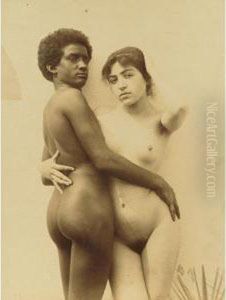Wilhelm Von Pluschow Paintings
Wilhelm von Plüschow, born Guglielmo Plüschow in Wismar, Grand Duchy of Mecklenburg-Schwerin (now Germany), on August 18, 1852, was a photographer who gained notoriety for his nude studies of Italian youths. In an era when photography was still in its infancy, Plüschow ventured into a genre that combined the classical beauty of the ancient world with the emerging medium of photography, creating works that were both artistic and controversial.
Plüschow came from a well-to-do family, which allowed him the freedom to pursue his artistic interests. In the early 1870s, he moved to Italy, the country that would become his adopted home and the backdrop for most of his work. Initially settling in Rome, he later moved to Naples. His cousin, Wilhelm von Gloeden, also a photographer, worked in Taormina, Sicily. Together, they played a significant role in the development of late 19th-century erotic photography, focusing particularly on the male nude.
Plüschow's technique and compositions were heavily influenced by classical art, as seen in the poses of his models, which often mimicked those of Greek and Roman statues. His work was characterized by its attention to aesthetic beauty, the natural elegance of his subjects, and the often idyllic settings in which he placed them. Despite the challenges of the time, including the legal and social taboos surrounding nudity and homosexuality, Plüschow managed to carve out a successful career. His photographs were sought after not just in Europe but across the Atlantic, contributing to the pictorialist movement in photography.
However, Plüschow's career was not without scandal. In 1902, he was arrested on charges related to his erotic photography and was subsequently forced to leave Naples. He returned to Rome, where he continued his work until his death on January 3, 1930. Although his reputation suffered during his lifetime due to the controversies surrounding his subjects, in the years following his death, Plüschow's work has been reevaluated. Today, he is recognized not only for his contributions to the field of photography but also for the way his work challenges and expands our understanding of beauty, sexuality, and art during the turn of the century. His photographs remain an important part of the history of art and photography, offering insight into the cultural and social mores of his time.
